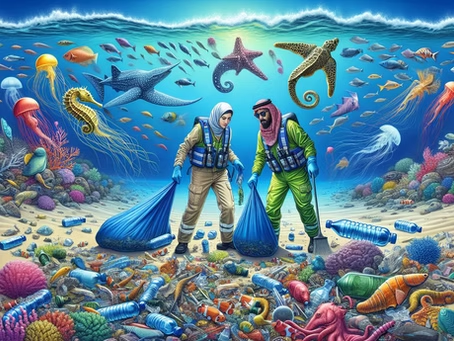Introduction
Marine pollution is one of the greatest threats to our oceans, endangering ecosystems, marine life, and human well-being. Combating this challenge requires innovation, collaboration, and bold policy shifts. From ocean-cleaning robots to sustainable aquaculture, organizations and individuals are working together to safeguard the seas. This article explores cutting-edge solutions, the role of companies like 4ocean, and how everyday choices contribute to a cleaner, healthier ocean.
Tackling the Tides of Trash
Autonomous Ocean-Cleaning Robots
Equipped with sensors and GPS, autonomous robots patrol the seas, removing debris without harming marine life. Powered by solar energy, they operate around the clock and recycle collected waste into usable resources. These machines represent a sustainable and scalable approach to plastic cleanup.
Innovative Recycling Initiatives
- Collection and sorting of debris
- Cutting-edge processing to break down plastics
- Manufacturing new products from recycled materials
Companies like Carbios are closing the loop on plastic waste, transforming pollution into value while reducing reliance on finite resources.
Community Beach Cleanups
Grassroots cleanups go beyond removing litter. They build environmental stewardship, spread education, and inspire sustainable habits. Every volunteer effort creates ripples of change, uniting communities in ocean protection.
Harnessing the Power of the Blue Economy
Offshore Wind and Wave Energy
Renewable energy projects reduce reliance on fossil fuels while supporting the blue economy. Though costly to develop, ocean energy offers resilience, long-term gains, and direct contributions to climate action.
Sustainable Aquaculture Technologies
Recirculating aquaculture systems, alternative feeds, and genetic improvements reduce environmental impact while meeting global seafood demand. These innovations cut waste and lessen pressure on wild fisheries.
The Potential of Tidal Energy
Tidal power is predictable, renewable, and emissions-free. With ongoing research and investment, tidal energy can play a pivotal role in sustainable energy transitions.
Revolutionizing Marine Protected Areas
Advanced Monitoring Systems
Drones, satellites, and machine learning enable real-time surveillance of Marine Protected Areas (MPAs), preventing illegal fishing and tracking ecosystem health.
Data-Driven Strategies
By analyzing large datasets, conservationists target critical habitats and adapt strategies dynamically, ensuring MPAs deliver tangible biodiversity benefits.
Overcoming the ‘Paper Park’ Challenge
Effective conservation requires enforcement, community participation, and innovative monitoring. By moving beyond symbolic protection, MPAs become true sanctuaries for marine life.
The Vanguard of Ocean Conservation
4ocean’s Innovative Projects
- Bracelets funding ocean cleanup
- Drones identifying pollution hotspots
- Advanced recycling of recovered plastics
4ocean merges business with conservation, proving that commerce can drive meaningful environmental impact.
Investing in Research and Development
Collaborations between startups, governments, and NGOs accelerate solutions. Patient investment and shared resources fuel long-term innovation for ocean conservation.
The Future of Pollution Cleanup
From smarter recycling to renewable energy integration, the next wave of innovation focuses on prevention as much as cleanup, reshaping how society interacts with the seas.
Closing the Tap on Plastic Pollution
Limiting Upstream Pollution
Targeting sources of microplastics—from textiles to tyres—is crucial. Stronger product design, policy enforcement, and regulation prevent waste before it reaches the ocean.
Industry Leadership
Companies are adopting circular economy models, investing in eco-friendly materials, and pioneering renewable energy projects that minimize their environmental footprint.
Global Cleanup and Policy Changes
Governmental Policies
Bans on single-use plastics, enforcement of marine sanctuaries, and incentives for industry set the foundation for change. Success depends on strong regulation and public participation.
NGO-Led Initiatives
Organizations like Conservation International mobilize communities, develop technologies, and advocate for stronger protections, filling gaps where governments fall short.
Ocean-Cleaning Technology
Autonomous robots, floating barriers, and pollution-spotting drones are scaling cleanup efforts while feeding into recycling programs that transform debris into new products.
Joining the Wave of Change
Individual Action
- Reducing single-use plastics
- Supporting sustainable businesses
- Participating in local cleanups
Every action contributes to ocean resilience, proving that collective responsibility begins with individual choices.
Supporting Local Initiatives
Volunteering for restoration projects, attending workshops, and advocating for coastal protection policies foster community-driven stewardship.
Sustainable Lifestyle and Advocacy
Consumers influence markets by choosing eco-conscious products and voicing support for systemic change. Advocacy amplifies impact, aligning communities with global conservation goals.
Corporate Responsibility in Ocean Stewardship
Circular Economy and Design
Durable, recyclable products and take-back schemes extend resource lifecycles, reducing waste and fostering innovation.
Corporate Sustainability Initiatives
Companies integrate environmental, social, and economic goals, often collaborating with startups and NGOs to scale solutions.
4ocean as a Model
By blending profitability with environmental impact, 4ocean demonstrates how corporate responsibility can power lasting change in marine conservation.
Conclusion
Marine pollution is vast, but innovation, collective action, and responsible leadership offer hope. From robots and renewable energy to grassroots cleanups and corporate initiatives, every effort counts. Together, we can ride the wave toward oceans free from pollution and thriving with life.

